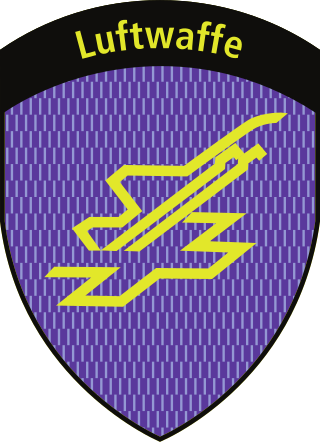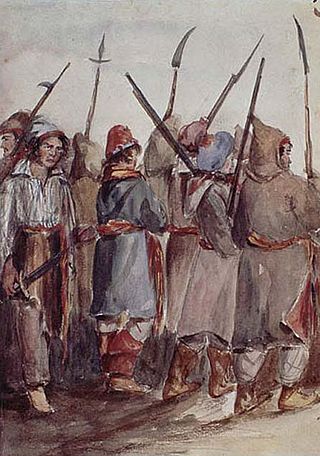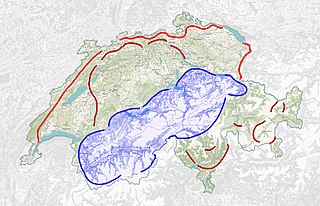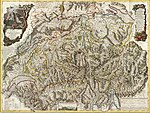
An army, ground force or land force is an armed force that fights primarily on land. In the broadest sense, it is the land-based military branch, service branch or armed service of a nation or country. It may also include aviation assets by possessing an army aviation component. Within a national military force, the word army may also mean a field army.

The Hungarian Defence Forces is the national defence force of Hungary. Since 2007, the Hungarian Armed Forces is under a unified command structure. The Ministry of Defence maintains the political and civil control over the army. A subordinate Joint Forces Command is coordinating and commanding the HDF corps. In 2020, the armed forces had 22,700 personnel on active duty. In 2019, military spending was $1.904 billion, about 1.22% of the country's GDP, well below the NATO target of 2%. In 2016, the government adopted a resolution in which it pledged to increase defence spending to 2.0% of GDP and the number of active personnel to 37,650 by 2026.

The Armed Forces of the Russian Federation, commonly referred to as the Russian Armed Forces, are the military of Russia. In terms of active-duty personnel, they are the world's fifth-largest military force, with 1.15 million and at least two million reserve personnel. According to the United States' Central Intelligence Agency (CIA), "Russia plans to expand its active personnel force to 1.5 million by 2026, which will make it the third largest in the world, after China and India." The country has three primary branches of service: the Ground Forces, the Navy, and the Aerospace Forces, as well as two independent arms of service: the Strategic Rocket Forces and Airborne Forces. In addition, the Special Operations Forces Command was established in 2013, with an estimated strength in 2022 of 1,000, possibly with additional supporting staff.

Switzerland, officially the Swiss Confederation, is a landlocked country located in west-central Europe. It is bordered by Italy to the south, France to the west, Germany to the north and Austria and Liechtenstein to the east. Switzerland is geographically divided among the Swiss Plateau, the Alps and the Jura; the Alps occupy the greater part of the territory, whereas most of the country's population of 9 million are concentrated on the plateau, which hosts its largest cities and economic centres, including Zürich, Geneva and Basel.

Since 1848 the Swiss Confederation has been a federal republic of relatively autonomous cantons, some of which have a history of federation that goes back more than 700 years, putting them among the world's oldest surviving republics.
The Swiss Armed Forces operates on land and in the air, serving as the primary armed forces of Switzerland. Under the country's militia system, regular soldiers constitute a small part of the military and the rest are conscripts or volunteers aged 19 to 34. Because of Switzerland's long history of neutrality, the Swiss Armed Forces do not take part in conflicts in other countries, but do participate in international peacekeeping missions. Switzerland is part of the NATO Partnership for Peace programme.

The Austrian Armed Forces are the combined military forces of Austria.

The Swiss mercenaries were a powerful infantry force constituted by professional soldiers originating from the cantons of the Old Swiss Confederacy. They were notable for their service in foreign armies, especially among the military forces of the kings of France, throughout the early modern period of European history, from the Late Middle Ages into the Renaissance. Their service as mercenaries was at its peak during the Renaissance, when their proven battlefield capabilities made them sought-after mercenary troops. There followed a period of decline, as technological and organizational advances counteracted the Swiss' advantages. Switzerland's military isolationism largely put an end to organized mercenary activity; the principal remnant of the practice is the Pontifical Swiss Guard at the Vatican.

The Swiss Air Force is the air component of the Swiss Armed Forces, established on 31 July 1914, three days after the outbreak of World War I, as a part of the army and in October 1936 as an independent service.

During World War I and World War II, Switzerland maintained armed neutrality, and was not invaded by its neighbors, in part because of its topography, much of which is mountainous. Germany was a threat and Switzerland built a powerful defense. It served as a "protecting power" for the belligerents of both sides, with a special role in helping prisoners of war. The belligerent states made it the scene for diplomacy, espionage, and commerce, as well as being a safe haven for 300,000 refugees.

Irregular military is any non-standard military component that is distinct from a country's national armed forces. Being defined by exclusion, there is significant variance in what comes under the term. It can refer to the type of military organization, or to the type of tactics used. An irregular military organization is one which is not part of the regular army organization. Without standard military unit organization, various more general names are often used; such organizations may be called a troop, group, unit, column, band, or force. Irregulars are soldiers or warriors that are members of these organizations, or are members of special military units that employ irregular military tactics. This also applies to irregular infantry and irregular cavalry units.

Henri Guisan was a Swiss military officer who held the office of General of the Swiss Armed Forces during the Second World War. He was the fourth and the most recent person to be appointed to the rarely used Swiss rank of general, and was possibly Switzerland's most famous soldier. He is best remembered for effectively mobilizing the Swiss military and population in order to prepare resistance against a possible invasion by Nazi Germany in 1940. Guisan was voted the fourth-greatest Swiss figure of all time in 2010.

Conrad Ulrich Sigmund Wille was the General of the Swiss Army during the First World War. Inspired by the Prussian techniques that he had been able to observe at the time of his studies in Berlin, he attempted to impress the Swiss Army with a spirit based on instruction, discipline and technical control.

A reservist is a person who is a member of a military reserve force. They are otherwise civilians, and in peacetime have careers outside the military. Reservists usually go for training on an annual basis to refresh their skills. This person is usually a former active-duty member of the armed forces, and they remain a reservist either voluntarily, or by obligation. In some countries such as Israel, Norway, Finland, Singapore, and Switzerland, reservists are conscripted soldiers who are called up for training and service when necessary.

A military reserve force is a military organization whose members (reservists) have military and civilian occupations. They are not normally kept under arms, and their main role is to be available when their military requires additional manpower. Reserve forces are generally considered part of a permanent standing body of armed forces, and allow a nation to reduce its peacetime military expenditures and maintain a force prepared for war. During peacetime, reservists typically serve part-time alongside a civilian job, although most reserve forces have a significant permanent full-time component as well. Reservists may be deployed for weeks or months-long missions during peacetime to support specific operations. During wartime, reservists may be kept in service for months or years at a time, although typically not for as long as active duty soldiers.
Swiss neutrality is one of the main principles of Switzerland's foreign policy which dictates that Switzerland is not to be involved in armed conflicts between other states. This policy is self-imposed and designed to ensure external security and promote peace.
The history of the Swiss Air Force began in 1914 with the establishment of an ad hoc force consisting of a handful of men in outdated and largely civilian aircraft. It was only in the 1930s that an effective air force was established at great cost, capable of inflicting several embarrassing defeats on the Nazi Luftwaffe in the course of an initially vigorous defence of neutral Swiss airspace. The Swiss Air Force as an autonomous military service was created in October 1936. After World War II it was renamed the Swiss Air Force and Anti-Aircraft Command and in 1996 became a separate service independent from the Army, under its present name Schweizer Luftwaffe.
The Swiss Red Cross, or SRC, is the national Red Cross society for Switzerland.

The Swiss National Redoubt is a defensive plan developed by the Swiss government beginning in the 1880s to respond to foreign invasion. In the opening years of the Second World War the plan was expanded and refined to deal with a potential German invasion. The term "National Redoubt" primarily refers to the fortifications begun in the 1880s that secured the mountainous central part of Switzerland, providing a defended refuge for a retreating Swiss Army.
Thirteen national referendums were held in Switzerland during 2016.





















